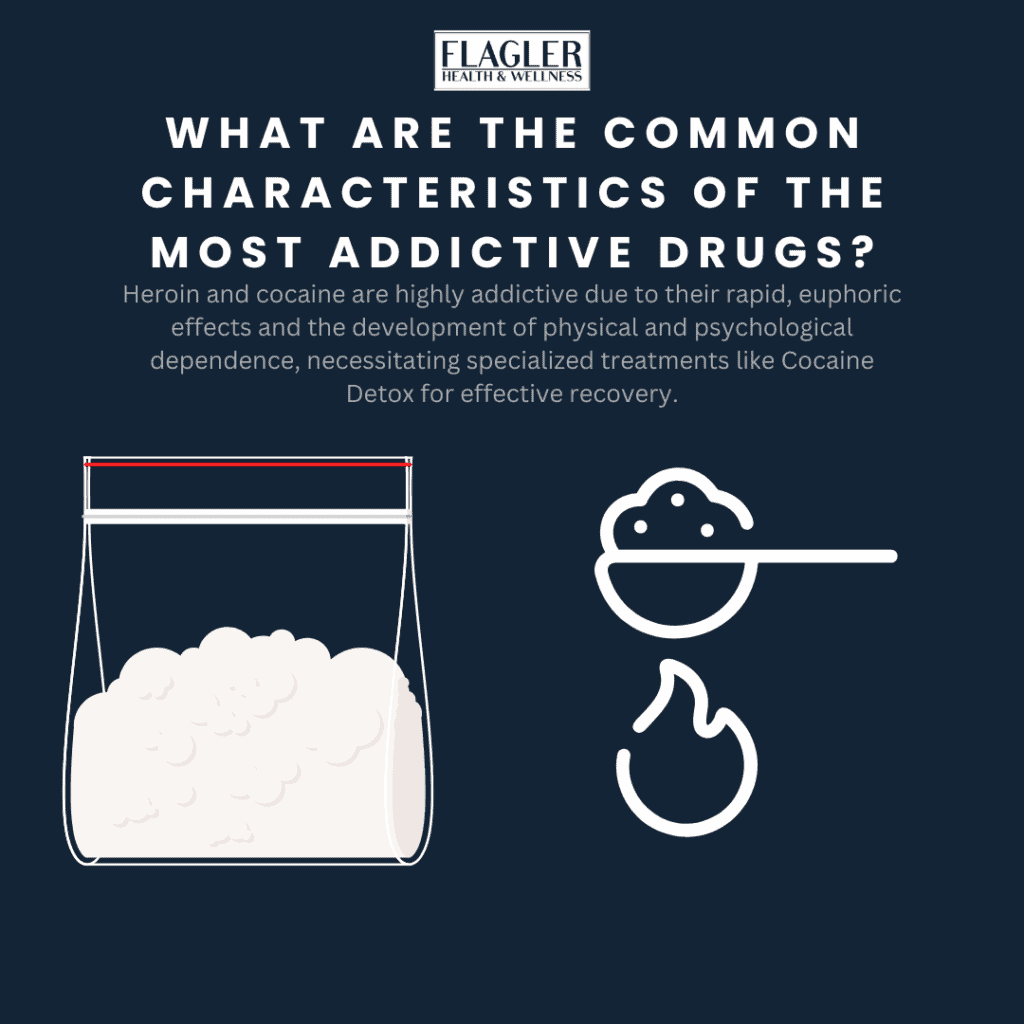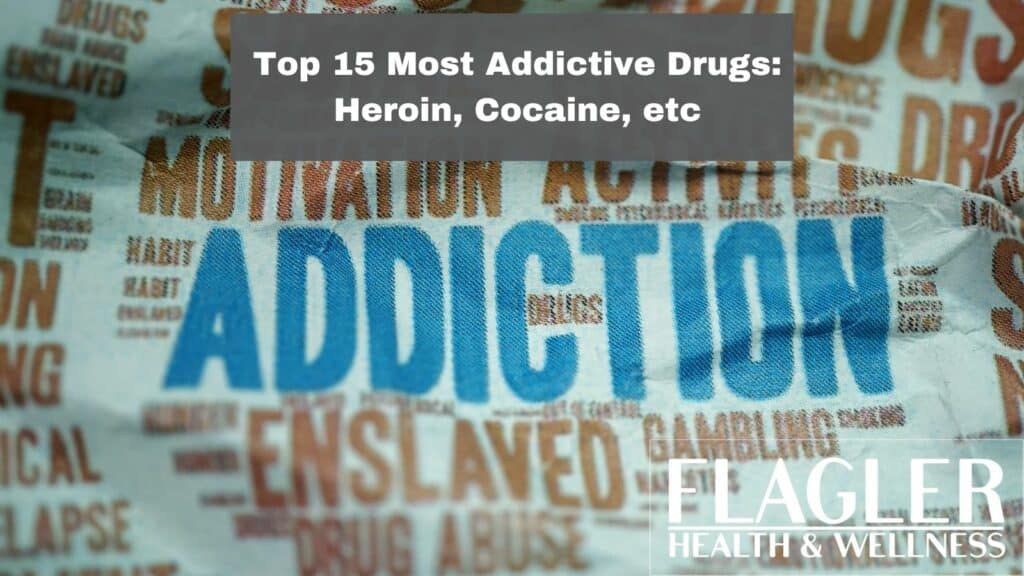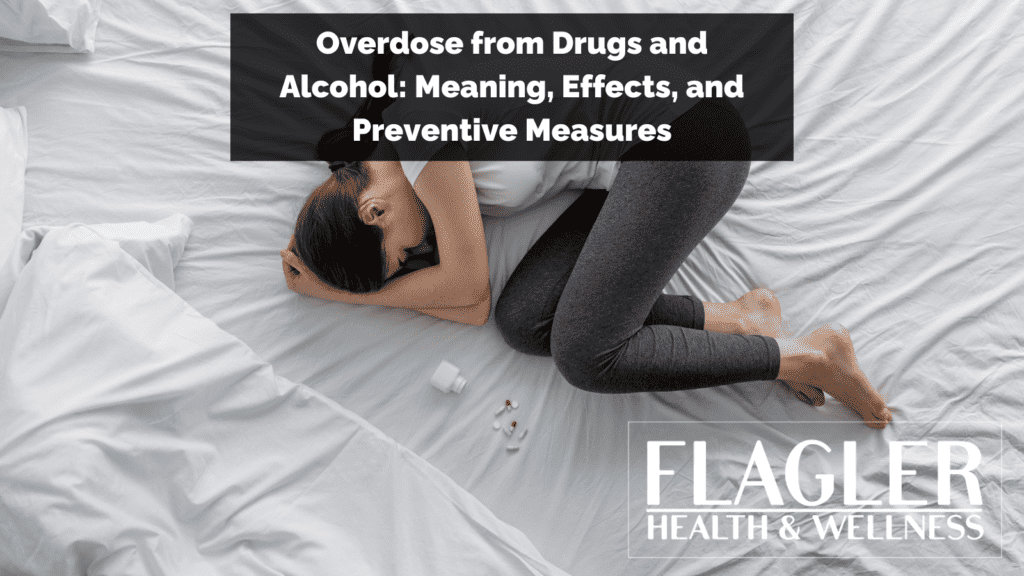Drug overdose is a serious problem in the United States. According to the National Institute on Drug Abuse, over 106,000 people died from drug overdoses in the U.S. in 2021, caused by both illicit drugs and prescription opioids. A recent report from the Centers for Disease Control and Prevention (CDC) looked at the drugs that most often cause overdoses. The report found that the 15 most common drugs involved in overdose deaths are:
- Alcohol
- Fentanyl
- Heroin
- Hydrocodone
- Methadone
- Morphine
- Oxycodone
- Cocaine
- Methamphetamines
- Alprazolam (Xanax)
- Diazepam (Valium)
- Nicotine
- Synthetic Cannabinoids (K2/Spice)
- MDMA (Ecstasy)
- Ketamine
Why Are Drugs Addictive?
As per the National Institute on Drug Abuse, most drugs influence the “reward circuit” of the brain. This results in experiencing euphoria and an increase in the production of dopamine, a chemical messenger. Drugs cause surges of dopamine in the reward circuit, which reinforces pleasurable but unhealthy behaviors like drug use and addiction.
This leads people to repeat the behavior again and again, resulting in addiction. The brain’s reward system is responsible for motivating individuals to repeat actions essential for their well-being, such as eating and spending time with loved ones.
As an individual continues to use drugs, their brain adjusts by reducing the ability of cells in the reward circuit to respond to it. This results in a decrease in the high that the person feels relative to the high they felt when they first took the drug, which is known as tolerance. They may consume more of the drug in an attempt to attain the same high. These adaptations in the brain frequently result in the person becoming less and less capable of deriving pleasure from things they previously enjoyed, such as food, sex, or social activities.
Long-term use of drugs causes changes in brain chemistry and circuits, affecting various functions, such as:
- Learning.
- Judgment.
- Decision-making.
- Stress.
- Memory.
- Behavior.
The 15 Most Addictive Drugs
1. Alcohol
Alcohol tops this “most addictive drugs list” due to its ready availability and the severe health implications and injuries associated with its consumption. Beer, wine, and liquor are all classified as alcoholic beverages. According to the CDC’s Alcohol-Related Disease Impact (ARDI) application, excessive alcohol consumption was responsible for over 140,000 deaths annually in the United States between 2015 and 2019. This translates to more than 380 deaths every day.
Alcohol abuse can lead to serious health problems such as cancer, liver damage, high blood pressure, heart disease, and harm to unborn babies. It also increases the risk of suicide, violence, and car accidents. Quitting alcohol suddenly can be life-threatening, so it’s important to seek medical help before attempting to detox. If you or someone you know experiences withdrawal symptoms when they stop drinking, it’s crucial to consider treatment options.
2. Fentanyl
Fentanyl is a very strong drug that is 100 times more potent than Morphine and is one of the most addictive drugs without a doubt. It causes many fatal and nonfatal overdoses in the US. Some drug dealers mix drugs with Fentanyl to make more money, and this can be very dangerous for the buyer. Sometimes, Fentanyl is added to pills without the buyer knowing, which makes it even more dangerous. Using even a small amount of illicit Fentanyl can be life-threatening. In 2021, there were over 70,000 overdose deaths involving Fentanyl. No amount of illicit Fentanyl is safe. If you or someone you know is using Fentanyl, please seek help from a treatment provider immediately as their life and health may be at risk.
3. Heroin
Heroin is a very dangerous drug that can cause serious health problems. People use it by either snorting it or injecting it into their veins. It’s a type of drug that is made from morphine and can look like either a white or brown powder or a black and sticky substance called Black Tar Heroin.
Heroin use can cause various health issues such as vein damage and heart lining infections. Approximately 103,000 Americans start using heroin each year, and the drug’s addictive properties can quickly lead to addiction.
Withdrawal symptoms can begin after just a few hours of not using it. Using Heroin can also cause many other serious problems, such as overdose, contracting infectious diseases, and permanent damage to the lungs, liver, kidneys, and brain. With the rising number of Opioid overdose deaths, it’s important to find treatment options as soon as possible if you or someone you know is struggling with addiction to Heroin.
4. Hydrocodone
Prescription medication Hydrocodone, like other Opioids, is one of the most addictive drugs. With continued use of Hydrocodone, the body may require higher doses to achieve the same effect, leading to an increased risk of overdose. Abuse of Hydrocodone can also impair cognitive and motor function, slow heart rate, and increase the risk of liver and kidney diseases. It can be difficult to recognize when someone is misusing Hydrocodone, but help is available for those who are struggling with addiction.
5. Methadone
Methadone is a medication that is used to help people who are addicted to heroin or morphine. It works by reducing the painful symptoms of withdrawal and blocking the effects of these drugs. However, between 2011 and 2016, methadone was involved in many overdose deaths.
Methadone is a type of drug that can slow down the body’s systems, such as breathing and blood pressure, and this effect can be dangerous if combined with other drugs like alcohol or benzodiazepines. If someone takes more methadone than they are supposed to or uses it in a way that is not recommended by their doctor, they are at risk of becoming addicted or suffering an overdose. In these cases, it may be necessary to seek treatment for methadone abuse.
6. Morphine
Morphine is a drug that is used to relieve severe pain. It falls under a category of drugs called Opioid analgesics. It is important to note that opioids, including prescription and illegal ones, have caused over 645,000 deaths between 1999 and 2021, according to the CDC. It is risky to drink alcohol, use prescription or non-prescription drugs that contain alcohol, or take street drugs along with Morphine as it can cause severe breathing problems, overdose, and death. Morphine can be addictive and has a high potential for abuse, even when used as directed. If you or someone you know shows signs of addiction to Morphine, it may be time to seek treatment options.
7. Oxycodone
Oxycodone is a medication that doctors usually prescribe to relieve severe pain or discomfort. But, when people use Oxycodone for fun or take it in a way that is different from what their doctor prescribed, the results can be dangerous. Oxycodone can be addictive and can cause serious problems if taken in large amounts or mixed with other drugs or alcohol. It can even be fatal. If someone is experiencing withdrawal symptoms or having a hard time controlling their use of Oxycodone, they may need to consider getting help.
8. Cocaine
The recreational drug known as Cocaine, or by other street names such as “Blow,” “Coke,” and “Crack,” is a potent stimulant that poses significant long-term health risks and of course, is one of the most addictive drugs. These risks include heart disease, hypertension, organ failure, respiratory distress, stroke, unhealthy weight loss, and seizures.
The National Institute on Drug Abuse reports that in 2021, about 4.8 million individuals aged 12 or older, or 1.7% of the population, reported using cocaine. If you are struggling to quit cocaine use, it is crucial to seek medical supervision before ceasing use, as withdrawal symptoms can be dangerous and life-threatening. Different therapies and support groups are available to help with treatment and long-term recovery.
9. Methamphetamines
Methamphetamines have addictive properties and are synthetic stimulants that can negatively impact one’s central nervous system and brain function over time. Using Methamphetamine can result in several long-term health problems such as psychosis, cardiovascular dysfunction, and an increased risk of infectious disease transmission.
It’s essential to note that even small amounts of Meth can cause harmful health effects, and no quantity is safe. If someone is struggling with quitting drug use or is unsure about the safe dosage of a substance, it is necessary to seek a professional addiction treatment.
10. Alprazolam (Xanax)
Xanax, a medication used to treat anxiety and insomnia, can be highly addictive if taken for long periods of time. It is especially dangerous when mixed with other drugs, and can cause cognitive impairment, delirium, and even psychosis. Taking more than the prescribed amount of Xanax or using it for recreational purposes can lead to addiction and overdose. It is important to recognize the warning signs of Xanax addiction and seek help.
11. Diazepam (Valium)
Diazepam is a medication that helps people with anxiety, muscle spasms, and seizures. It’s commonly known as Valium. Some people misuse this medicine because they think it’s safe and easy to get, but it’s very dangerous to use it the wrong way. If someone uses Diazepam for a long time, they will have many problems, like trouble sleeping, hallucinations, feeling more anxious, and having seizures that can be deadly.
Diazepam can also make it hard to breathe if it’s taken with other drugs that act on the brain. This is why it’s important to be careful and talk to a doctor before taking Diazepam, or any other drug. If someone starts using Diazepam as a recreational drug, they should know that it’s not safe and they might need help to stop using it.
12. Nicotine
There has been a rise in the number of young people at risk of developing an addiction to Nicotine, a highly addictive substance found in tobacco products and e-cigarettes. Despite the prevalence of marketing campaigns promoting Nicotine-filled products, such as e-cigarettes, the dangers of Nicotine addiction and its harmful effects have not decreased. In fact, according to the NIDA, about 22.0% or roughly 61.6 million people reported using tobacco products or vaping nicotine in 30 days during 2021.
13. Synthetic Cannabinoids (K2/Spice)
Be cautious of substances labeled as “synthetic Marijuana” or “fake weed,” as they may contain lab-made chemicals that can alter the mind similarly to those found in the Marijuana plant. Despite being marketed as a safer alternative, Synthetic Cannabinoids can cause unpredictable and dangerous effects. In fact, they can affect the brain more intensely than Marijuana, leading to side effects such as extreme anxiety, confusion, paranoia, and hallucinations.
Additionally, Synthetic Cannabinoids have been linked to severe mental and physical health problems such as vomiting, violent behavior, increased heart rate, and even suicidal thoughts. As these substances are often labeled as “not safe for human consumption” and have a high potential for abuse, it’s important to consider seeking treatment if you or someone you know uses them.
14. MDMA (Ecstasy)
One specific danger of MDMA is that it is often cut with other substances, sometimes unknown to the buyer. These substances include Cocaine, LSD, Heroin, and Amphetamine, and when an individual takes multiple substances, the risk of overdosing increases substantially.
Additionally, MDMA use can lead to an increase in heart rate to dangerous levels and cause a sharp rise in body temperature. This can ultimately lead to kidney failure and even death. It is crucial to understand that since MDMA is an illicit substance, any use is considered abuse, and no amount can be deemed “safe” as continued use can lead to psychological or physical dependence. However, for those individuals who are using MDMA, treatment options are available.
15. Ketamine
The use of Ketamine as an anesthetic in both human and veterinary practice can induce a sensation of complete detachment that is similar to a near-death experience. High doses of Ketamine can have severe health consequences, including impaired memory, impaired motor function, high blood pressure, and potentially fatal breathing problems. It is dangerous to use Ketamine recreationally, and the risk of overdose increases significantly when it is combined with other drugs such as Opiates or Amphetamines.
What Are The Most Addictive Drugs For Teenagers?
According to the latest findings from the Monitoring the Future survey, adolescents’ substance use patterns over the past year were mainly focused on alcohol, nicotine vaping, and cannabis. The overall usage rates remained consistent with those reported in 2021, with only a few instances of increased usage reported between 2021 and 2022. Moreover, the majority of these instances stayed at or below the levels observed before the pandemic in 2020.
Breaking it down further:
- Nicotine vaping: In the past year, the rates of nicotine vaping remained consistent across all three grades surveyed. 12% of eighth graders, 20.5% of 10th graders, and 27.3% of 12th graders reported vaping nicotine.
- Cannabis use: The use of cannabis remained stable across all three grades. In the past year, 8.3% of eighth graders, 19.5% of 10th graders, and 30.7% of 12th graders reported cannabis use. Vaping cannabis showed a stable trend for eighth and 12th graders, with a slight increase among 10th graders, but it still remained below pre-pandemic levels.
- Alcohol use: Alcohol use remained stable among eighth and tenth graders (15.2% and 31.3%, respectively) but returned to pre-pandemic levels among twelfth graders in 2022, with 51.9% reporting alcohol use in the past year.
- Illicit drug use (excluding marijuana): The rates of illicit drug use, aside from marijuana, have remained stable across all three grades. In the past year, 4.9% of eighth graders, 5.7% of 10th graders, and 8.0% of 12th graders reported using any illicit drug other than marijuana.
- Narcotics use (excluding heroin): Narcotics use among 12th graders slightly increased to 1.7% in 2022 from 1.4% in 2021 but remained consistent with pre-pandemic levels (2.7% in 2019 and 2.1% in 2020).
What Are The Most Addictive Things Besides Drugs?
It’s worth noting that addiction can extend beyond drugs and alcohol. According to experts, anything that can provide relief from stress or discomfort can be addictive. People tend to seek out activities that bring them happiness or euphoria, especially if the effects are immediate.
However, once the high wears off, regret and shame may occur. To avoid the comedown, individuals may develop a dependence on substances or behaviors that offer relief. This can lead to a dangerous cycle of addiction, which can develop with anything from food to video games.
These are the most common non-drug addictions:
- Fast Food Addiction.
- Love Addiction.
- Plastic Surgery Addiction.
- Shopping Addiction.
- Internet Gaming.
- Exercise Addiction.
- Compulsive Lying.

What are the common characteristics of the most addictive drugs like heroin and cocaine?
The most addictive drugs, including heroin and cocaine, are known for their rapid onset of effects and intense euphoria. They significantly increase dopamine levels in the brain, enhancing feelings of pleasure and reward. This immediate and powerful impact is a key characteristic that contributes to their high addictive potential. These substances also lead to the development of both physical and psychological dependence, where the absence of the drug leads to intense cravings and withdrawal symptoms.
In addressing addiction to these substances, treatments like Cocaine Detox and heroin rehabilitation are crucial. These detox programs are specifically designed to manage withdrawal symptoms and reduce the risk of relapse. They often include medical supervision and various therapies to address the psychological aspects of addiction. The goal is to aid individuals in breaking the cycle of dependence, providing a foundation for long-term recovery and a return to healthier living.
Drug Addiction Treatment Programs in West Palm Beach FL
Find your way to a better life and get addiction treatment in West Palm Beach, FL. Our center provides expert care and treatment for addiction in a welcoming environment. From the safe and supervised detox process to a comprehensive inpatient rehab program that addresses both your mental and physical health, we have the tools to help you overcome addiction and get back on your feet.
Our compassionate team will be with you every step of the way, offering personalized support to guide you toward long-term recovery. Begin your journey towards a brighter future with us today.
Share This Post







